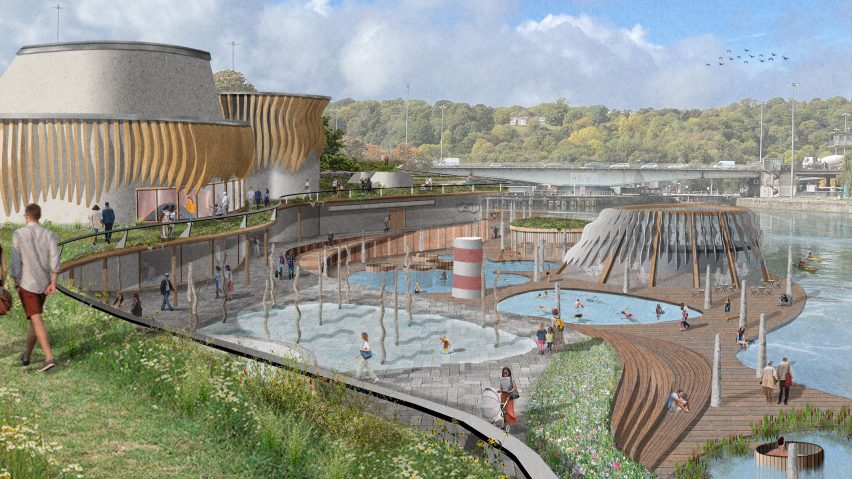
Eight architecture projects by students at Cardiff University
Dezeen School Shows: a memorial for monuments that aims to preserve a city's heritage is included in Dezeen's latest school show by students at Cardiff University.
Also featured is an apartment block that is designed to blend into the cityscape and a project that aims to unite people through food and cooking.
Cardiff University
Institution: Cardiff University
School: Welsh School of Architecture
Course: Master of Architecture
Tutors: Juliet Davis, Steven Coombs, Mhairi McVicar and Sam Clark
School statement:
"The Welsh School of Architecture (WSA) is a world-leading and agenda-setting school of architecture in Cardiff.
"We provide a vibrant and collaborative environment for teaching and research. Embracing the diversity and transdisciplinarity of architecture, our school pursues excellence in research and innovation in teaching and learning across design, the arts, humanities and sciences.
"Our mission as a school is to contribute to the creation of a built environment that enhances people's lives now while contributing to the wellbeing of future generations.
"We foster a strong studio culture, encouraging students to confront complex situations and issues with curiosity, intelligence and creativity.
"Our teaching is directly informed by active research, practice and engagement work across five research and scholarship groups with a focus on urbanism; design research and practice; history, heritage and conservation; computational methods in architecture; energy, environment and people.
"The school's recently expanded facilities include new workshops, digital lab, robotic arm, and design studios with an emphasis on supporting a creative and curious learning environment.
"Our Master of Architecture (MArch) encourages students to forge a personal stance grounded within critical, reflective, creative and interdisciplinary approaches to design.
"While bridging the gap between practice and research across the two distinct years of the MArch, we ask the same question in both: what is your position within the discipline and profession of architecture regarding specific experiences and issues?
"In the 2022/2023 academic year, MArch I students enjoyed new opportunities to engage with and reflect on diverse practice experiences, informing the academic and design studies which they conduct in parallel.
"Within our refurbished Bute building, MArch II students returned to a vibrant studio culture, also benefiting from access to new workshops, offering enhanced opportunities to develop their research-led design thesis.
"Within a framework of eight design units, each of which set out its own architectural agenda, each student is encouraged to explore an independent stance, establishing and defending an architectural position through the design process.
"As well as the design thesis, the student's architectural position is informed by a written dissertation and studies in the practice, management and economics of architecture.
"Locating initial individual or group research within cultural, political, tectonic, environmental, historical, philosophical, or other approaches defined by the unit, students develop an individual thesis with a specific site, programme and research question emerging from the primer.
"As the individual design theses emerged, year-wide practice and technology talks and workshops supported the exploration of topics as varied as mental health, low carbon strategies, sustainable urban drainage, landscape, public life, digital conservation tools, timber, air quality, computing craft and architectural agency.
"The 2022/2023 MArch II theses demonstrate commitments to sustainable, equitable, generous and thoughtful ways of approaching architecture, exploring independent critical positions and speculations which align to WSA's ethos of 'grounded creativity' and the collective pursuit of an ethical position within architectural practice."
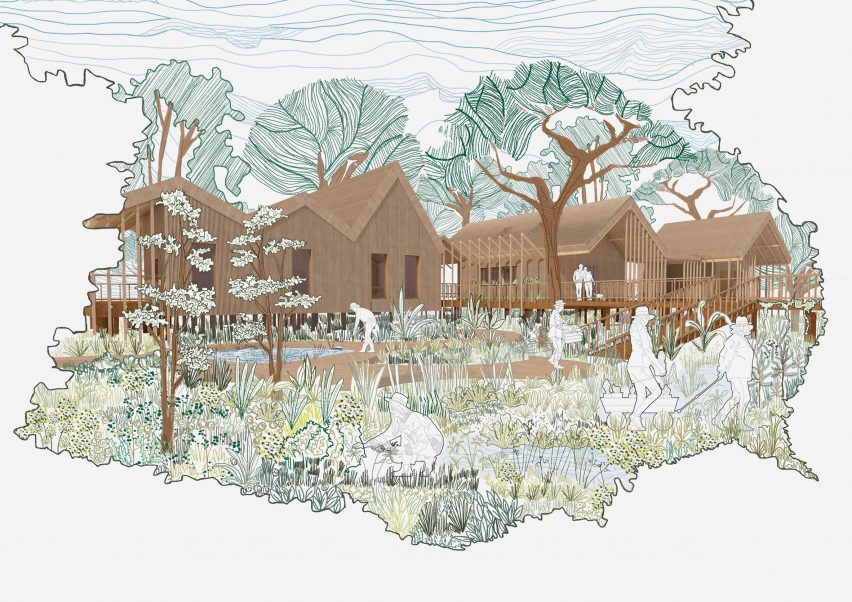
Y Morfa Pantri by Priyansha Kamdar
"Over the past decade, we have lost over 90 per cent of our wetlands in the UK. Wetlands play a key role in capturing excess carbon dioxide, enhancing flood mitigation, improving soil health and providing ecological stability.
"This proposal aims to rehabilitate the Morfa Wetlands in Carmarthen, Wales, through a regenerative agricultural production that is housed within a set of pavilions scattered in the landscape.
"The scheme introduces foraging within an edible landscape masterplan, which encourages sustainable food practices, provides for research and learning as well as encourages local trade within Carmarthen.
"Through the use of straw bale insulation – a rule that restricts the use of cement and the use of locally-grown building material – this net-zero carbon proposal aims to regenerate the way Carmarthen and the UK grows and consumes food."
Student: Priyansha Kamdar
Unit: Unit XI Carmarthen
Tutor: Rural Office
Email: priyanshakamdar[at]gmail.com

One Coach House at a Time by James Miller
"Situated in Grangetown, Cardiff, research ascertains that communities want to feel empowered by regeneration and not overwhelmed by unrealistic masterplans.
"Therefore, this thesis questions the effectiveness of large-scale regeneration by initiating change on a small scale, integrating the community rather than dismissing them.
"Reflecting a personal position against the standardisation of details within large developments, this proposal investigates the delicate decision-making of the One Coach House scheme.
"It explores how valued quality is elevated by paying attention to components that are usually overlooked such as the envelope, the threshold and the gutter. Overall, this thesis examines how Grangetown can grow one coach house at a time."
Student: James Miller
Unit: Unit XII Value
Tutors: Prof Mhairi McVicar and Dan Benham
Email: jajmiller19[at]gmail.com
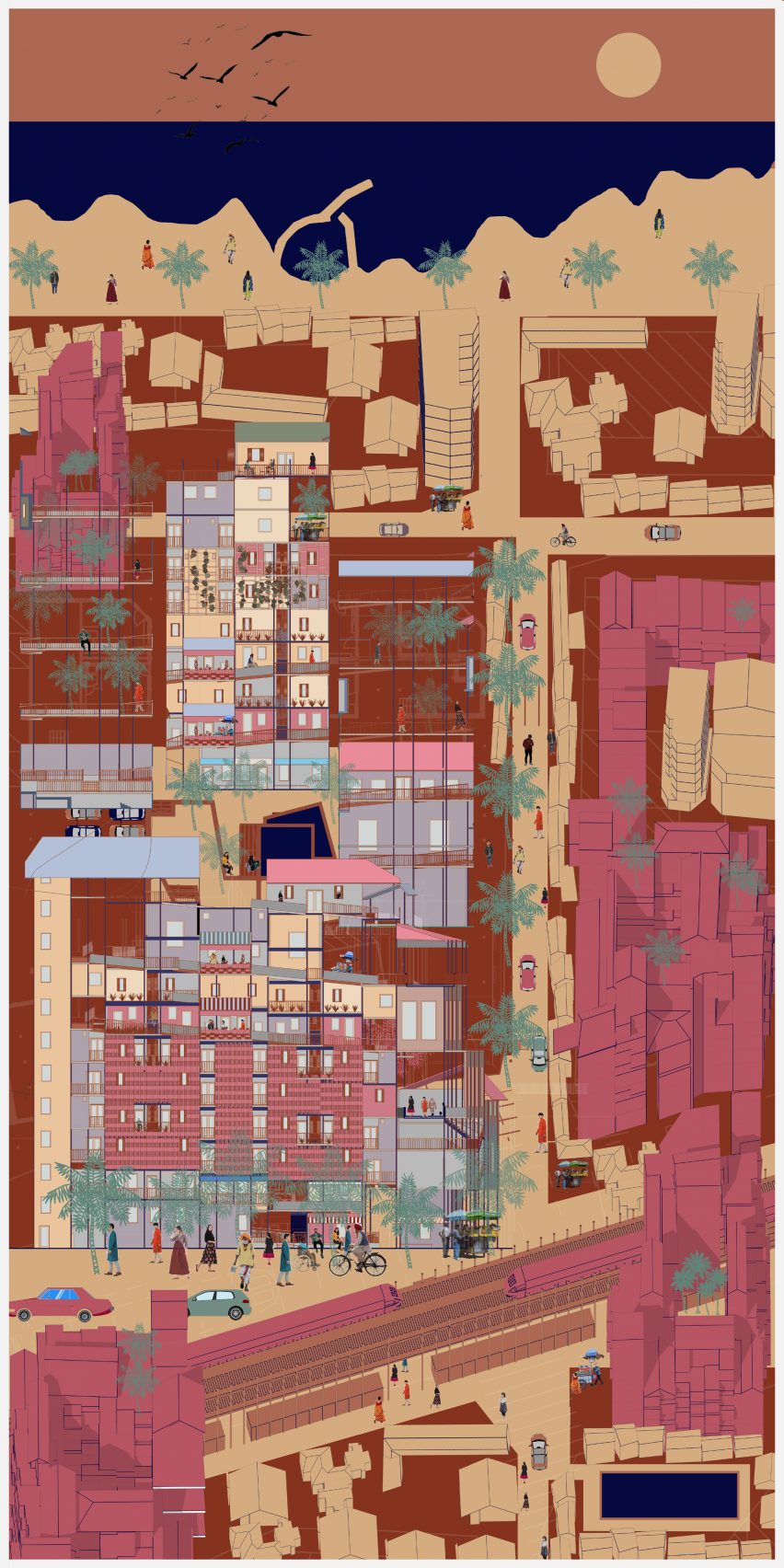
Collective Ascend by Michail Bradinoff
"This project explores alternative design approaches for housing, providing environmentally, economically and socially sustainable solutions to the challenges faced by cities of the future that are growing exponentially.
"The wider urban strategy focuses on densifying areas around the stations of the newly proposed metro and railway line, encouraging use of sustainable transport and better social connections within a neighbourhood.
"Collective Ascend is a series of high-rise mixed-use blocks that are designed to serve as a continuation of the city rather than isolated objects.
"Therefore, a publicly accessible ramp guides all users to the various levels of the structure where one can find access to train platforms, small-scale shops, street vendors, offices, cafes, residential buildings and green areas."
Student: Michail Bradinoff
Unit: Unit XIII Liveable Urbanism
Tutor: Dr Shibu Raman
Email: bradinoffm[at]gmail.com
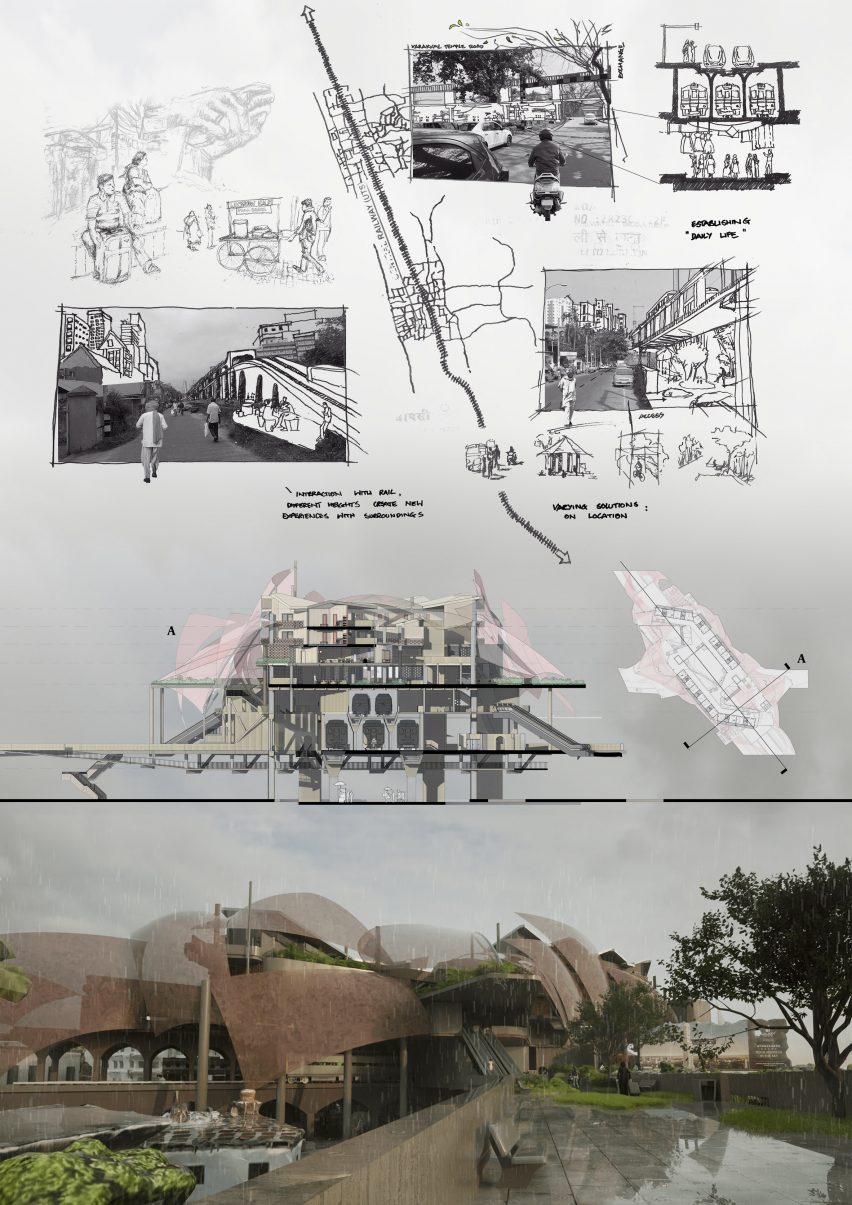
Urbanism as a Cure by Luke Celinski
"Calicut, India, has a sprawling layout that cultivates physical inactivity and increased car usage, leading to congestion, air pollution and stress.
"This project proposes a series of urban strategy and public transport infrastructure, such as the metrorail, to improve the environment, using innovative methods and utilising existing infrastructure to address ground and visual concerns.
"By optimising daily travel, it enhances transportation and active mobility all while introducing a citywide programme that modifies the social systems that produce health-related risks.
"Through the establishment of a vital hub, this endeavour demonstrates how the physical environment can catalyse transformative change in people's lifestyles."
Student: Luke Celinski
Unit: Unit XIII Liveable Urbanism
Tutor: Dr Shibu Raman
Email: luke.celinski[at]gmail.com
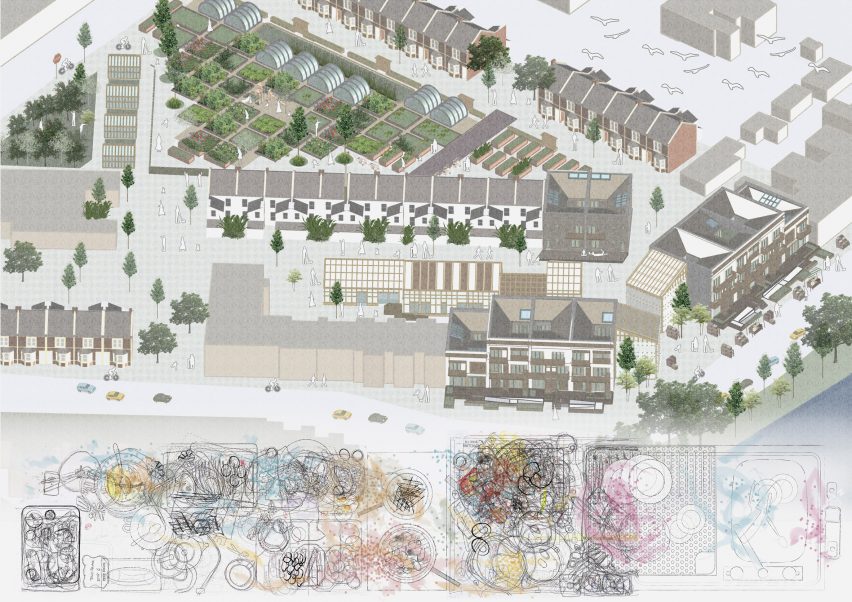
Haveli Gardens: The Kitchenless Cooperative City by Aina Fadzil
"Rooted in the exploration of kitchens, this project promotes unity through shared domestic work, igniting a vibrant resurgence of human connections.
"Inspired by the cooperative city concept where kitchens are sparse, this project envisions homes to transcend boundaries and craft vibrant communal spaces that rekindle connections amidst shared zones.
"The shared zones include communal kitchens, markets, courtyards, and verandas, community exchanges thrive. By harnessing untapped food-making potential, the 'extended home' model disperses amenities across adaptable public realms, fostering unity.
"From bustling markets to collaborative kitchens, this venture embodies sustainable and multi-generational living, transforming homes into unity-embracing sanctuaries, nurturing cultural ties and architecturally innovating community bonds."
Student: Aina Fadzil
Unit: Unit XIV Dwelling Differently
Tutor: Dr Sam Clark
Email: ainafadzil01[at]gmail.com
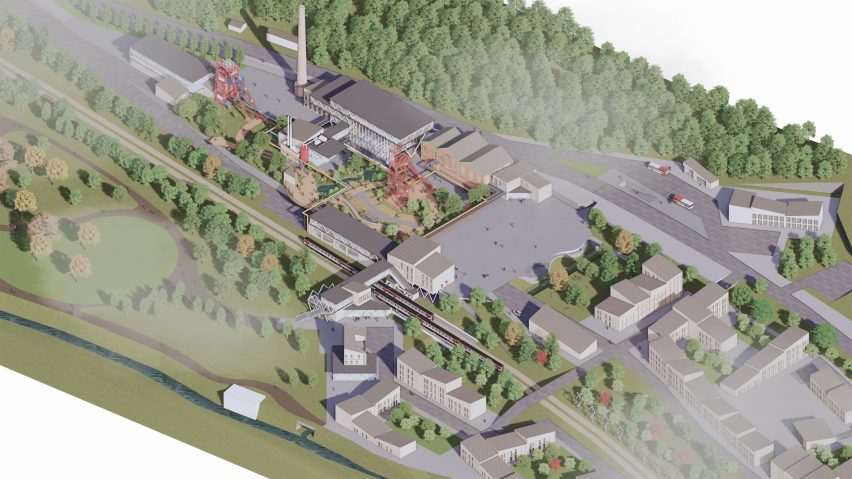
Parc Ynni Cefn Coed Energy Park by Morgan Rhys Taylor
"The Cefn Coed Energy Park envisages a revitalisation of an underfunded colliery museum, refocusing the concept of the museum to energy.
"The vision sees the creation of a national energy museum for Wales, UK, in its place, moving away from the oversaturated colliery theme to a unique museum format, looking at the past, present and future of energy.
"The masterplan centres around the sub-themes of industrial, mobility and domestic energy. The focus around energy stems from the global concerns of climate change and the more recent energy crisis, aiming to provide more attention to energy within all levels of architecture."
Student: Morgan Rhys Taylor
Unit: Unit XVIII Carbon Pasts, Low Carbon Futures
Tutor: Dr Chris Whitman
Email: MorganRhys.Architecture[at]outlook.com
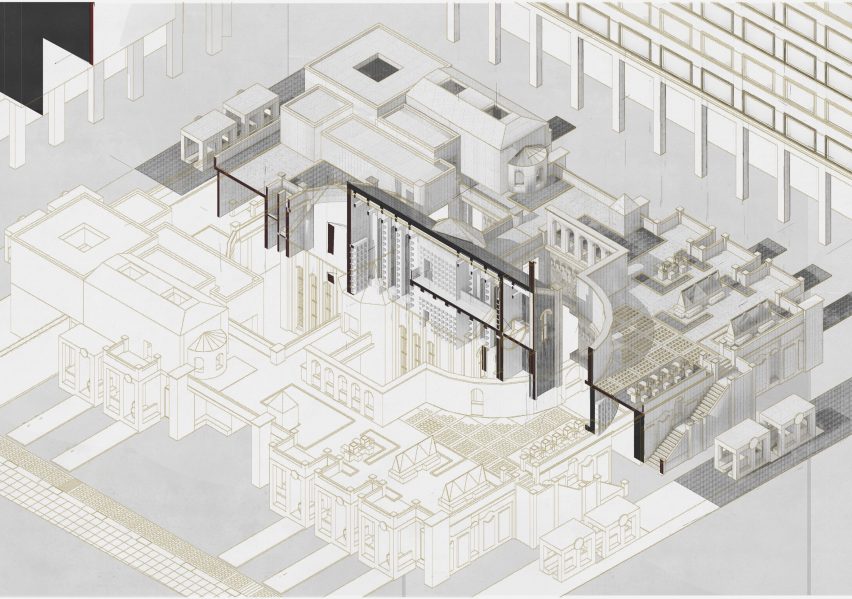
Moulding Memories: An Architectural Elegy to the Lost Monuments of Bottonuto by Irina-Alexandra Gherman
"This project explores the legacy of 'lost monuments,' guiding the city and its residents toward a rightful journey of mourning irreparable losses.
"By intertwining Sigmund Freud's mourning theory and Peter Sack's English elegy, a unique methodology for erecting memorials emerges, harmonising past remembrance with present significance.
"Similar to personal mourning, a city must embrace acceptance in the wake of the disappearance of its monuments, enabling new memories to intertwine with its collective memory.
"This innovative approach culminates in a poignant and forward-facing memorial that safeguards the city's shared memory and secures its presence in the future."
Student: Irina-Alexandra Gherman
Unit: Unit XX Designing Histories
Tutor: Alexis Germanos
Email: irina.gherman98[at]gmail.com
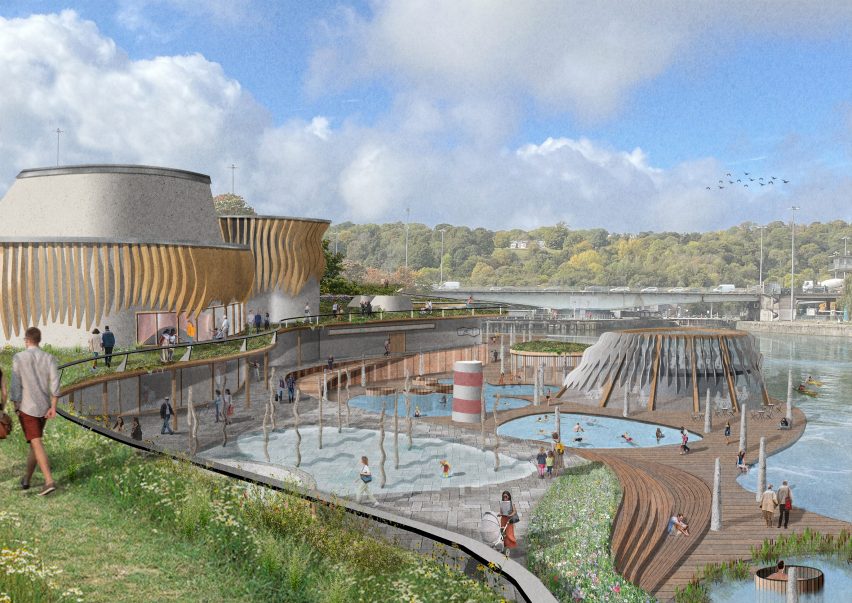
Beyond the Edge by Jennifer Marett
"This thesis proposes that access to public outdoor water spaces improves health and wellbeing within communities.
"Through a lack of connection to water, England has seen its water quality decrease. This thesis aims to create safe spaces that connect the community with water in Bristol Harbour, aiming to improve mental and physical wellbeing.
"This project features innovative methods of water purification to educate the public about the importance of maintaining water quality – it aligns with Bristol's sustainability goals by improving the harbour's water quality.
"Using principles of biomimicry design, the project delves into existing mycelium research to guide design decisions."
Student: Jennifer Marett
Unit: Unit XVII Regenerative Vision
Tutors: Shankari Raj and Lawrence Duck
Email: marett.jenny[at]gmail.com
Partnership content
This school show is a partnership between Dezeen and Cardiff University. Find out more about Dezeen partnership content here.